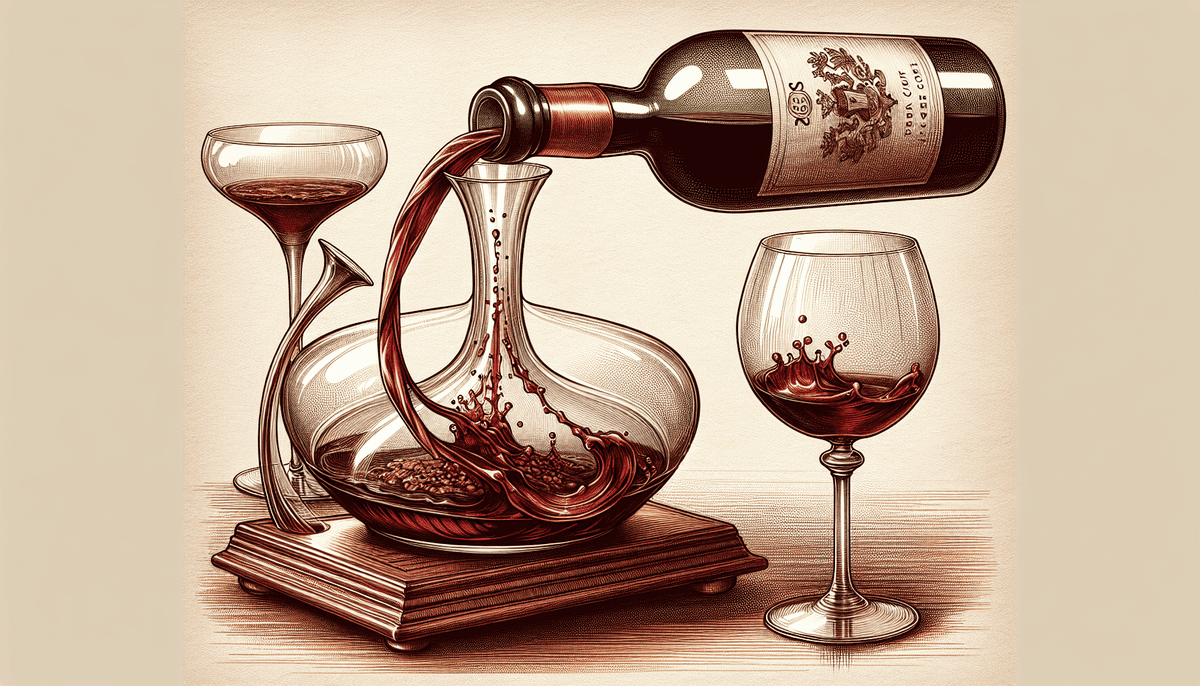Storing port wine correctly is essential to preserving its rich texture and deep flavors. But what’s the best way to do it?
This guide on how to store port wine cuts straight to the chase: from the optimal climate to the right bottle position, learn the key steps to keep both your unopened and opened port in top condition without overcomplicating the process.
Welcome to Didi Somm – let’s raise our glasses and dive in.
Important Notice: The information in this article is for general and public information purposes only. It solely reflects Didi Somm’s or his Staff’s opinion, and no responsibility can be assumed for errors or omissions in the service’s contents. For details, please check the Disclaimer at the bottom of the homepage.

“How to Store Port Wine” – Key Takeaways
Unopened Bottles:
– Store in cool (60-65°F [15-18°C]), dark conditions with 70-75% humidity
– Avoid vibrations and fluctuating temperatures
After Opening:
– Seal tightly and store upright below 50°F (10°C)
– Consume vintage Ports relatively quickly to preserve quality
– Other Port styles can last 4-6 weeks refrigerated
Serving:
– Let bottles warm up 1-2 hours before serving
– Ideal temps: Vintage/LBV 60-65°F (16-18°C), Ruby/Reserve 55-60°F (13-16°C), Tawny 50-55°F (10-13°C)
– Consider decanting to allow wine to breathe and open up flavors
Storing Port Wine: The Essentials
An unopened bottle of port wine boasts an impressive shelf life, reflecting the robust nature of this fortified beverage. Yet to fully reap the benefits of its longevity requires more than just a tight seal—it demands optimal storage conditions.
Whether you choose a dedicated wine cellar or find solace beneath your bed for storing unopened bottles, maintaining proper environmental factors is crucial.
The Art of Preserving Port Wine centers on three critical elements:
Suitable storage conditions for unopened bottles
Correct positioning for Vintage Port Wines
Meticulous care once opened
The above three key areas significantly contribute to retaining the flavor profile and integrity, allowing you to enjoy the rich taste experience that makes every sip of port memorable.
Ideal Conditions for Unopened Port
For an unopened port to remain pristine, it’s essential that it be kept in a state of tranquility within an environment where the temperature remains constant at around 60 degrees Fahrenheit (15 degrees Celsius). Storing your port wine in such a cool and shadowy spot ensures its successful maturation, allowing it to evolve into something truly extraordinary over time.
Ensuring humidity is maintained within the 70-75% range is just as critical. This specific moisture level prevents the cork from becoming desiccated, which would otherwise allow air penetration, causing degradation of the precious liquid inside. The storage space should also avoid any vibrations and must shield against light exposure since direct sunlight can damage the quality of the wine.
Proper Orientation for Vintage Ports
Shifting the focus to the delicate nuances of storing vintage ports, it’s crucial that both vintage and crusted ports receive special attention regarding their positioning while stored. These varieties must lie on their side to ensure the cork retains moisture, thereby maintaining a tight seal throughout the maturation process.
When putting away your vintage ports:
Lay them horizontally so as to preserve cork hydration. This wards off unwanted oxidation.
Should the cork dry out, oxygen may infiltrate and spoil the quality of the port.
Be alert for corks that have begun pushing outward from bottles—they could indicate harmful oxidative effects.
Keeping a wet cork is essential for safeguarding vintage ports against deterioration!
Storing Opened Bottles of Port

The battle to maintain its freshness and taste ensues as soon as a bottle of port is uncorked. The key lies in preserving the wine’s integrity post-enjoyment. Ensure that an opened bottle of vintage port wine is re-closed promptly with either the original cork or a substitute reusable stopper to combat oxygen infiltration which can lead to oxidation.
Following this, it’s essential to situate your sealed bottle upright at cool temperatures not exceeding 10°C / 50°F – placing it in a refrigerator would be most suitable. Chilled environments help decelerate oxidative processes, thereby sustaining the port’s quality for extended periods. To Curtail contact with air, transfer any excess wine into smaller vessels, which effectively adds extra shelf life.
Despite these measures, though, one must recognize that time remains unforgivingly finite. Fresh consumption becomes critical, especially for vintage ports – such bottles are optimally drunk a few days after their opening, while those boasting vintages over four decades old demand indulgence within twenty-four or forty-eight hours to best capture their distinguished flavors. Port wines securely sealed using synthetic T-shaped corks can usually endure up to three weeks henceforth.
It’s crucial that you relish your open bottle of port expediently, enjoying every sip without forgetting that promptness enhances each experience.
Perfecting the Port Wine Environment

Crafting the optimal setting for your Port Wine is comparable to orchestrating a symphony, where every component needs to resonate perfectly, contributing to an exquisite whole. The storage conditions for port wine should be carefully calibrated as follows:
Cool and consistent in temperature, ideally not surpassing 15°C (60°F)
Sheltered from light
Isolated from any vibration
Featuring steady temperature maintenance
This orchestration of conditions protects the vibrancy of the port wine, shielding it against early aging and maintaining its deep flavors.
Understanding what constitutes this ideal environment for your bottle can often be related to employing a dedicated wine fridge or investigating other available storage methods. Each option provides crucial insights into creating an impeccable atmosphere that promises fullness and durability in each sip of your treasured port.
Choosing the Right Wine Fridge
A reliable wine fridge safeguards your port wine’s integrity and longevity, ensuring the flavor remains intact. However, not every wine fridge offers the same preservation quality. To best care for your port, select a fridge capable of offering steady temperatures, minimal vibration disturbance, and protection from light.
For storing port wine specifically, thermo-electric coolers are highly recommended due to their low-vibration operation, which is less likely to disrupt the sediment within port wines during maturation. Yet if you’re watching your wallet closely while making this investment in preserving your fine wines, take heart! Economically priced second-hand units can adequately provide these vital storage conditions without breaking the bank.
Alternative Storage Solutions
Even without a wine fridge, you can adequately store your port wine in a cool, dark place such as a cupboard or room. An everyday refrigerator might work to keep your port cool temporarily. It’s not ideal for extended storage because the temperature is too variable, and the door opens often.
When improvisation is necessary, use ingenuity to maintain an optimal environment for storing your wine. Placing frozen water bottles inside non-specialized areas can decrease temperatures slightly. This ingenious hack has notable effects on safeguarding both the flavor and integrity of your beloved port wine.
Serving Port Wine: Temperature & Technique
The time to savor the complex flavors of your port wine is upon us. Serving this distinguished beverage transcends simply transferring it into a glass. It’s an expression of finesse and culture. Every action, from decanting the wine to choosing the appropriate stemware, amplifies your enjoyment of each sip. The temperature at which you serve various styles of ports can profoundly influence their bouquet and palate.
While understanding how to serve port properly is important, so too is embracing its rich customs when enjoying such wines with others. For example, passing vintage ports clockwise around a dinner table exudes charm and has functional benefits rooted in camaraderie.
Finally, yet important, We must delve into specifics regarding proper service temperatures for different types or styles of port—in particular, those for high-quality vintage varieties—to guarantee optimal tasting conditions.
Decanting and Serving Vintage Ports

The decantation of vintage ports is an essential aspect of their service. This step ensures the wine is sufficiently oxygenated, opening up to exhibit its complete array of scents and tastes. For a perfect taste experience, the timing when you decant these ports matters significantly. Those under 40 years of age benefit from being decanted for two to three hours before they are drunk, while those over 40 should be aerated between half an hour and one hour before serving.
To prepare for decanting, the bottle must remain upright for a while so that any sediment can settle at the bottom. During the delicate process of pouring into another vessel – a practice that may incorporate using a filter – caution must be taken not to disturb this natural deposit resulting from aging. Having sediment end up in your glass diminishes the enjoyment of this storied beverage.
The Correct Temperatures for Different Styles of Port
To maximize the enjoyment of port wines, serving them at optimal temperatures that highlight their distinctive qualities is crucial. A young ruby port is best enjoyed just below ambient temperature—specifically within the range of 60°F to 64°F. At this temperature, a ruby port’s robust fruity essence and pronounced tannins are given center stage.
Conversely, Tawny Ports require cooler conditions due to their greater exposure to oxidation throughout maturation. Chilling these ports slightly – to between 55°F and 58°F—will amplify their nutty taste profiles and intricate scents, creating an exceptional tasting journey.
Every style of port encapsulates its unique terroir as well as its individual aging process. Serving each type at its ideal temperature allows each bottle’s narrative to unfold most expressively. Thus, when storing ports, ensuring such prime storage environments is critical in maintaining the distinctiveness intrinsic to these exquisite wines.
Long-Term Preservation of Port Wine

The maturation of port wine is a fascinating tale of time’s passage, carefully moderated temperatures, and deliberate oxygen contact that ultimately defines its unique taste profile. In the same way, cheese evolves in flavor over time, and so does port undergo transformation. Vintage ports are transferred to bottles after their initial two-year oak barrel aging period. Then they proceed to age gracefully within the serenity of cool dark cellars for extended durations—sometimes up to 20 years—which bestows upon them an acclaimed complexity.
This enchantment varies across the spectrum of port varieties and hinges on multiple elements. It’s worth exploring how different types of ports fare concerning longevity and examining what factors play pivotal roles in steering the aging process for this illustrious type of wine.
Aging Potential of Various Port Types
Vintage port distinguishes itself from other styles of port, such as tawny and ruby, with its exceptional aging capabilities in the bottle. Left unopened, these vintage ports can continue to mature for two decades or sometimes even surpass thirty years.
The relatively brief wood aging period and extended bottle maturation contribute significantly to their complexity and unique qualities.
Contrarily, most port types, including tawny and ruby varieties, do not experience development once bottled. Unlike vintage bottles sealed with conventional corks designed for prolonged aging, those topped with T-Cap corks are meant for more immediate consumption post-purchase.
This variance in maturity potential reflects the wide range and intricacies inherent within this potent fortified wine category.
Factors Affecting Port Wine Aging
Several elements impact the maturation of port wine. One significant factor is its fortification with spirits, which elevates acetaldehyde levels and encourages the creation of anthocyanin-tannin complexes that help maintain Port’s hue as it ages.
Cork closures also shape port’s aging trajectory. These stoppers leach substances into the port, affecting its color and flavor profile over time.
Port can mature undesirably if stored improperly under conditions like inconsistent or excessive heat. This may lead to a degraded quality where the wine becomes dull and stewed in character. Grasping these influential factors is key to ensuring proper aging and preserving Port’s distinctive taste.
Common Misconceptions About Storing Port
Many people mistakenly think that port wine, when sealed and unopened, doesn’t last very long. Unlike regular table wines, port – a type of fortified wine – benefits from a longer shelf life because its high sugar and alcohol levels act as preservatives.
One reason aficionados highly value fortified wines like sealed port is the ability to endure over time. This durability is among the numerous characteristics that distinguish them in the world of fine wines.

Ensuring Quality: Checking for Spoilage
Each bottle of port wine holds its unique allure, but to preserve this allure, vigilant care is essential. Being able to identify indications of deterioration is vital for maintaining the high standard of your port. Tiny bubbles appearing in non-sparkling types can suggest secondary fermentation has occurred, leading to a spoiled and unpleasantly tart flavor.
The odors that arise from a bottle are also indicative clues about the state of the wine. Aroma notes characterized by mustiness, moldiness, or resembling vinegar usually point towards spoilage triggered by chemical reactions or oxidation because the wine has been exposed excessively to air over time. The integrity of the port is compromised when these off-putting flavors match an unexpected sweetness in varieties meant not to be sweet or present as overly sharp vinegary undertones.
By staying alert – to scent and sight – you’ll guarantee that every pour from your prized bottles maintains the exquisite enjoyment expected when you serve and store ports with diligence.
FAQ – How to store port wine
1. How long can an unopened bottle of Port last?
An unopened bottle of Port can last 20-100 years or more if properly stored. Vintage Ports can age for decades, while ruby and tawny Ports typically last 4-6 years after bottling.
2. What is the ideal humidity level for storing Port?
The ideal humidity range for storing Port is 60-70%. Too low humidity can cause corks to dry out, while too high can lead to mold issues.
3. Can Port be stored in the refrigerator before opening?
It’s best not to store unopened Port bottles in the refrigerator, as the cool temperatures can cause the wine to lose some flavors and complexity over time.
4. Should Port be stored away from light?
Yes, UV light can prematurely age Port wine. Store bottles in a dark environment or use opaque or dark glass containers.
5. Can Port be stored lying down or only standing up?
For unopened bottles, Port should be stored lying on its side to keep the cork moist. Once opened, keep Port standing upright.
6. How can you tell if an unopened Port is deteriorating?
Signs include a soggy, leaking, or pushed-out cork, sediment visibly stuck to the bottle walls, or an unpleasant odor when uncorked.
7. Is it ok to store red and white ports together?
Yes, the storage conditions for red and white fortified Ports are generally the same in terms of temperature, humidity, and light exposure.
8. Can Port be stored long-term with other wines?
Port will keep longer than most table wines if stored properly. However, its higher alcohol can potentially dry out corks of table wines over many years of storage.
9. Should Port be decanted before serving?
Decanting helps separate the wine from any sediment and allows it to breathe, which enhances the aromas and flavors, especially when serving vintage Port.
10. Are there any precautions needed when moving Port for storage?
Minimize any shaking or vibrations that can disturb the sediment in Port Wine. Wrap bottles well and keep them upright when transporting.
11. How long can you keep port once opened?
After opening, port wine can be preserved for approximately 4 to 6 weeks in a cool, dark environment without significant quality loss.
Aim to consume Ruby Port within one month, and Tawny Port should be finished within two months.
12. Does port need to be stored on its side?
Indeed, for optimal maturation, Port must be kept on its side in an environment that is both dark and moist with a constant temperature maintained between 55°F and 65°F.
13. Should you refrigerate port wine?
Certainly, it is advisable to refrigerate port wine upon opening, be it Ruby or Tawny variety, as this practice helps protect the wine from exposure to light and elevated temperatures.
14. Can port wine be stored at room temperature?
No, the variability of room temperature makes it unsuitable for preserving unopened port wine over an extended period.
For optimal storage, maintain a consistent temperature of around 60 degrees Fahrenheit in a cool, dark environment.
15. What are the signs of spoilage in port wine?
If you detect the presence of tiny bubbles, encounter an aroma reminiscent of must or vinegar, or taste something unusually sweet or vinegary, your port wine may have deteriorated. Be vigilant for these indicators to ascertain the integrity of its quality.
Conclusion
To preserve the rich flavors of Port wines, they must be stored in a cool, humid environment away from light and vibrations, properly positioned vintage Ports during aging, and refrigerated opened bottles. When you consume Port Wines, we recommend using proper serving techniques, like decanting vintage Port Wines and serving them at their optimal temperature.
Additionally, knowing the aging potential of different ports and signs of spoilage will help you monitor the wines’ evolution over time and keep them in their best storage condition.
Enjoy the rich flavors of your Port Wines – Cheers!
For your reference, the latest articles by “Didi Somm” include:
- How to Organize a Wine Cellar? – 9 Best Tips to Organize Your Wine Collection
- Wine Aging Made Easy: How to Use a Wine Fridge in Cellaring?
- What Temperature Should a Wine Fridge Be? – 7 Expert Tips
- Single Zone or Dual Zone Wine Fridge: How to Choose the Best for You?
- The Art of Wine Preservation: What is a Wine Fridge in 7 Exciting Steps
- Thrilling Showdown: Wine Fridge vs Beverage Fridge – Find Out Here
Important Notice: The information in this article is for general and public information purposes only. It solely reflects Didi Somm’s or his Staff’s opinion, and no responsibility can be assumed for errors or omissions in the Service’s contents – for details, please check the Disclaimer at the bottom of the homepage.







